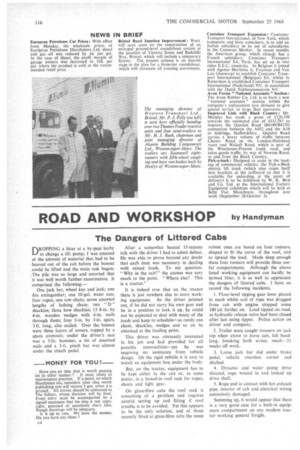ROAD AND WORKSHOP by Handyman
Page 120

If you've noticed an error in this article please click here to report it so we can fix it.
The Dangers of Littered Cabs
.DROPPING a fitter at a by-pass layby to change a lift pump, I was amazed at the amount of material that had to be .heaved out of the cab before the bonnet could be lifted and the main task begun. The pile was so large and assorted that it was well worth further examination. It comprised the following:—
One jack bar, wheel key and jack; one fire extinguisher; one 10-gal, water can; four ropes; one tow chain; seven assorted lengths of lashing chain; two " D " shackles; three bow shackles; 13 8-in. by 4-in, wooden wedges with 6-in, nails through them; four 3-in. by 3-in. spars, 3 ft. long, also nailed. Over the bonnet were three layers of covers, topped by a spare overcoat; under the driver's seat was a 3-1b. hammer, a tin of assorted nails and a 3-ft. pinch bar was almost under the clutch pedal. After a somewhat heated 15-minute talk with the driver I had to admit defeat. He was able to prove beyond any doubt that eaeh item was necessary in dealing with mixed loads. To my question: "Why in the cab?" the answer was very much to the point. "Where else? This is a tractor."
It is indeed true that on the tractor there is just nowhere else to store working equipment. As the driver pointed out, if he did not carry his own gear and be in a position to lock it up, he could not be expected to deal with many of the loads and keep to schedule--as rarely can chain, shackles, wedges and so on be obtained at the loading point.
This driver was obviously interested in his job and had provided for all possible eventualities—yet he was rec,eiving no assistance from vehicle design. On the rigid vehicle it is easy to install an equipment box under the body.
But, on the tractor, equipment has to be kept either in the cab or, as some prefer, in a boxed-in roof rack for ropes, sheets and light gear.
On glass-fibre cabs the roof rack is something of a problem and requires careful setting up and fitting if roof trouble is to be avoided. Yet this appears to be the only solution, and of those recently fitted to glass-fibre cabs the more
robust ones are based on four runners, shaped to fit the curve of the roof, and so spread the load. Made deep enough these four runners will provide three useful compartments. Although the above listed working equipment can hardly be termed litter, it is as well to appreciate the dangers of littered cabs, I have on record the following incidents.
1. Floor-level tipping gear lever placed in mesh whilst coil of rope was dragged from cab with engine stopped some 180 yd. farther on. Load tipped on road, as hydraulic release valve had been closed after last using tipper. Police action on driver and company, 2. Trailer mate caught trousers on jack top when about to leave cab, fell headlong, breaking both wrists; result-2I weeks off work.
3. Loose jack bar slid under brake pedal, vehicle overshot corner and ditched.
4. Dynamo and water pump drive sheared, rope wound in and locked up drive shaft.
5. Rope end in contact with hot exhaust pipe, interior of cab and electrical wiring extensively damaged.
Summing up, it would appear that there' is a very good case for a built-in equipment compartment on any modern tractor working general freight,






































































































































































































































































































































































































